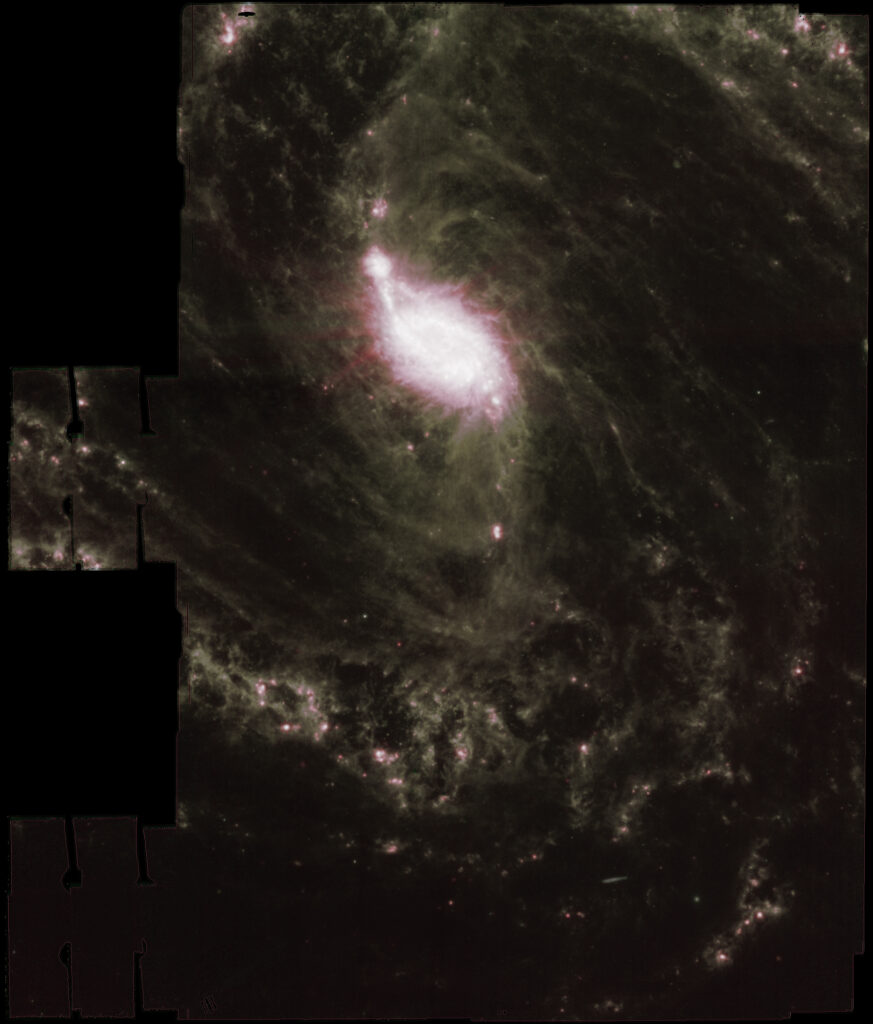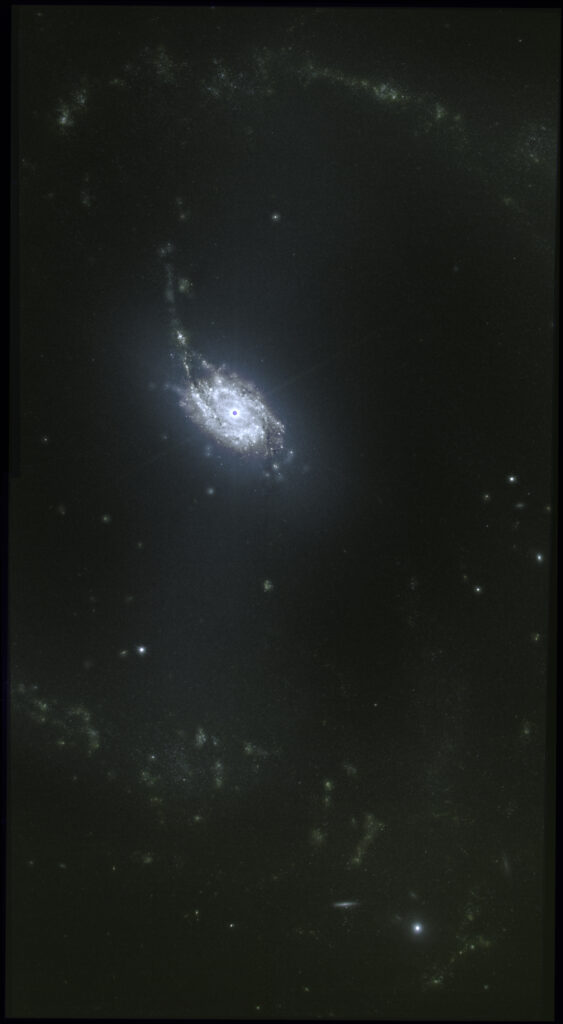NGC3521 in LRGB
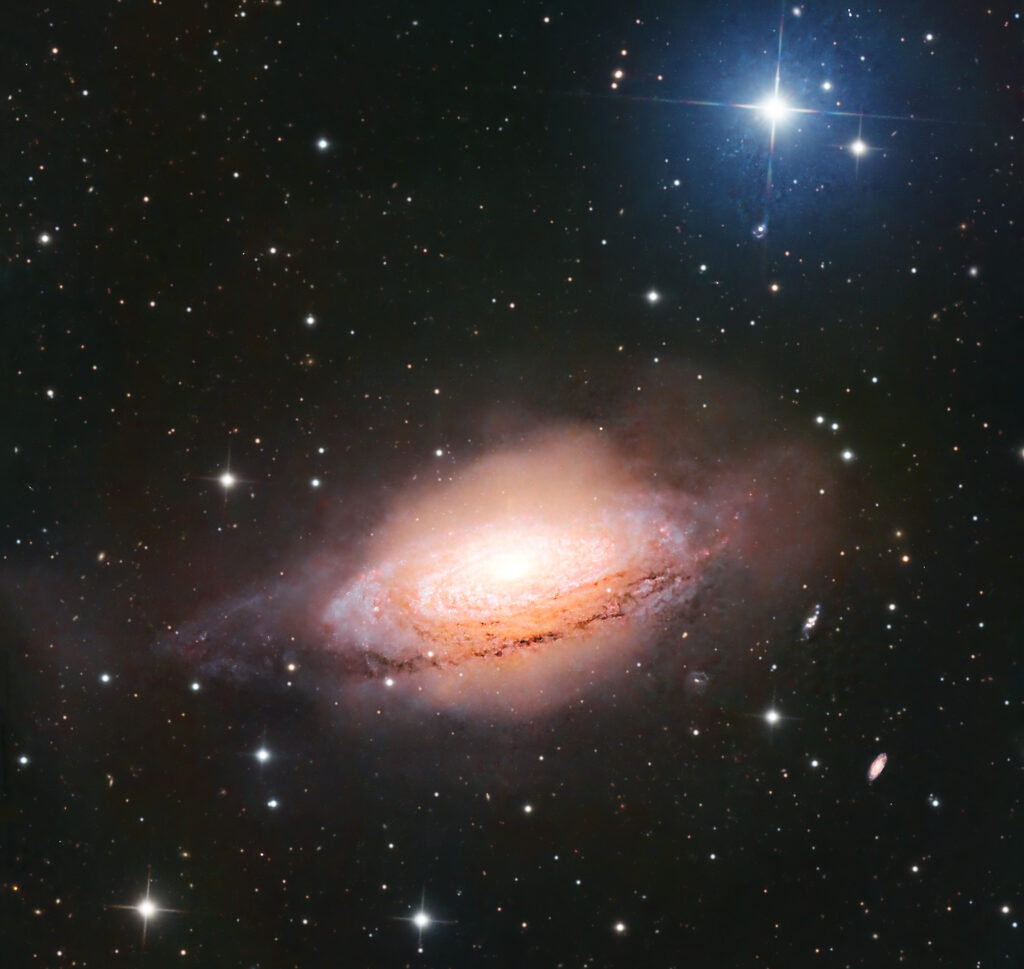
NGC3521 Galaxy in LRGB 300 seconds subframes, Planewave CDK24 and QHY 600M Pro CMOS at -10C, from Rio Hurtado Valley observatory in Chile, Telescopelive Network.
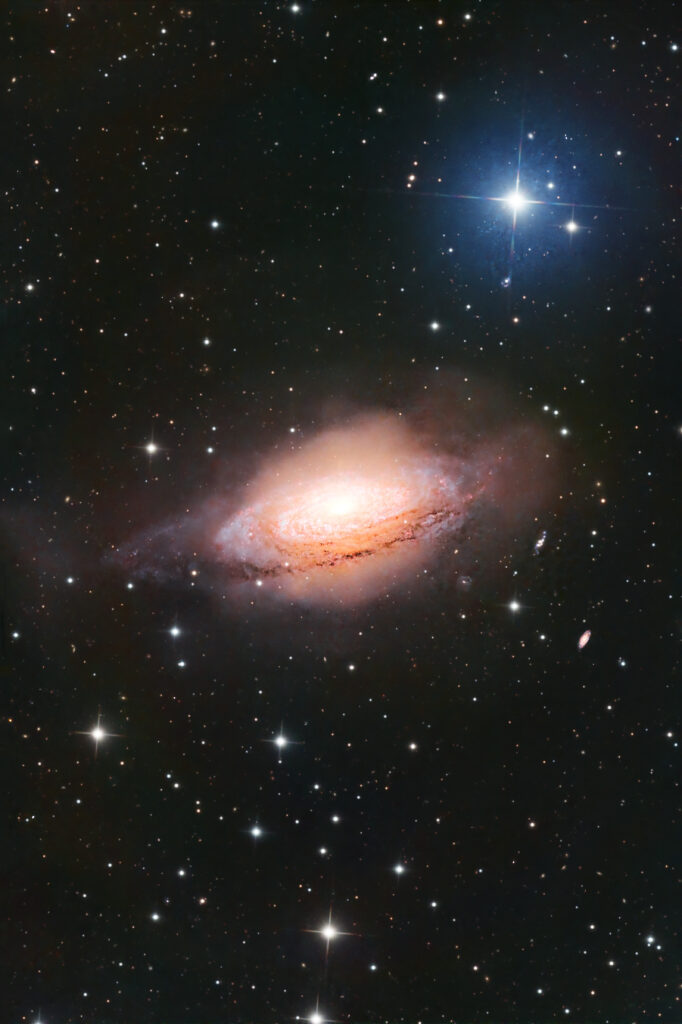
Astrobin: https://www.astrobin.com/hvt4xr/B/

NGC3521 Galaxy in LRGB 300 seconds subframes, Planewave CDK24 and QHY 600M Pro CMOS at -10C, from Rio Hurtado Valley observatory in Chile, Telescopelive Network.

Astrobin: https://www.astrobin.com/hvt4xr/B/

Galaxy IC342 in LRGB, single session, 2 subframes for channel, 600sec, Officina Stellare ProRC 700 with Proline FLI PL16803 at BIN2, IC Astronomy Observatory of Spain, from Telescopelive network.
A very hard postproduction because of few signal and not so good quality of data, but I really stocked into this processing.
Astrobin:
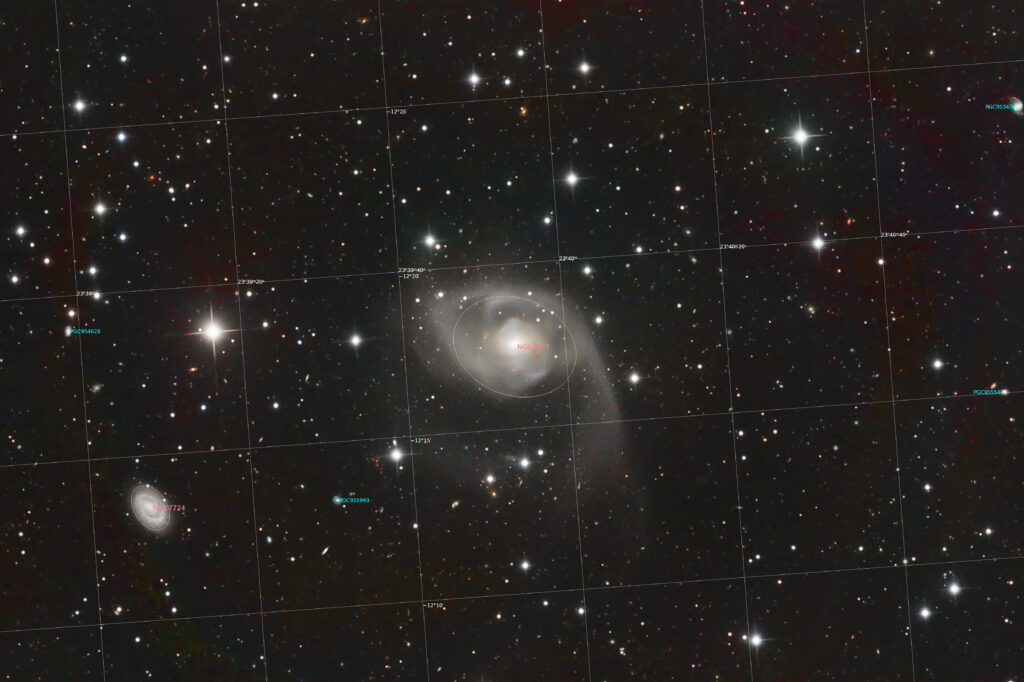
According to Karina Voggel and Colleagues investigation of 2022 focused about NGC7727 galaxy in Aquarius, as merging of two distinct galaxies, it was evinced that both host a SMBH – super-massive black hole; cfr. Karina T. Voggel, Anil C. Seth, Holger Baumgardt, Bernd Husemann, Nadine Neumayer, Michael Hilker, Renuka Pechetti, Steffen Mieske, Antoine Dumont and Iskren Georgiev, 2022 “First direct dynamical detection of a dual supermassive black hole system at sub-kiloparsec separation” in Astronomy & Astrophysics, Vol.658: A152 [doi https://doi.org/10.1051/0004-6361/202140827]
Crabtree and Smecker-Hane 1994 researches gave datation of galaxies merging at about 1 billion years ago: cfr. Crabtree Dennis R. and Smecker-Hane Tammy, 1994 “Young Star Clusters and CO Gas in the Galaxy Merger, NGC 7727 (Arp 222)” in American Astronomical Society, 185th AAS Meeting, id.107.14; Bulletin of the American Astronomical Society, Vol. 26, p.1499 [https://ui.adsabs.harvard.edu/abs/1994AAS…18510714C/abstract]
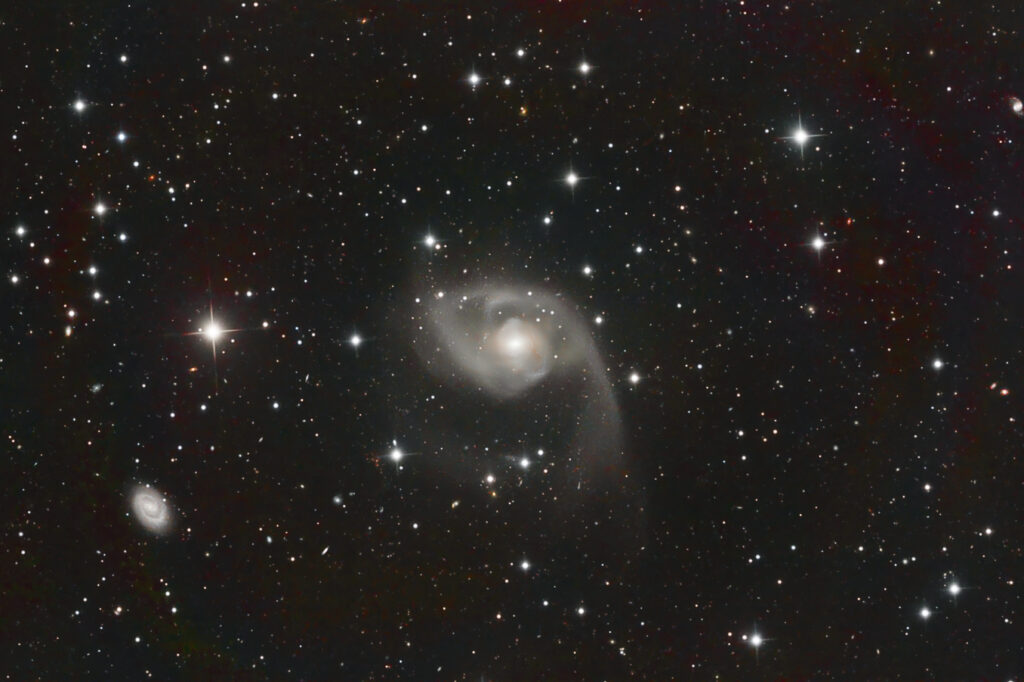
Astrobin:
LRGB 300sec subframes recorded between 11/08/2023 and 22/08/2023 by Planewave CDK24 and QHY 600M Pro CMOS camera from Telescoplive network El Sauce Observatory in Rio Hurtado Valley, Chile.
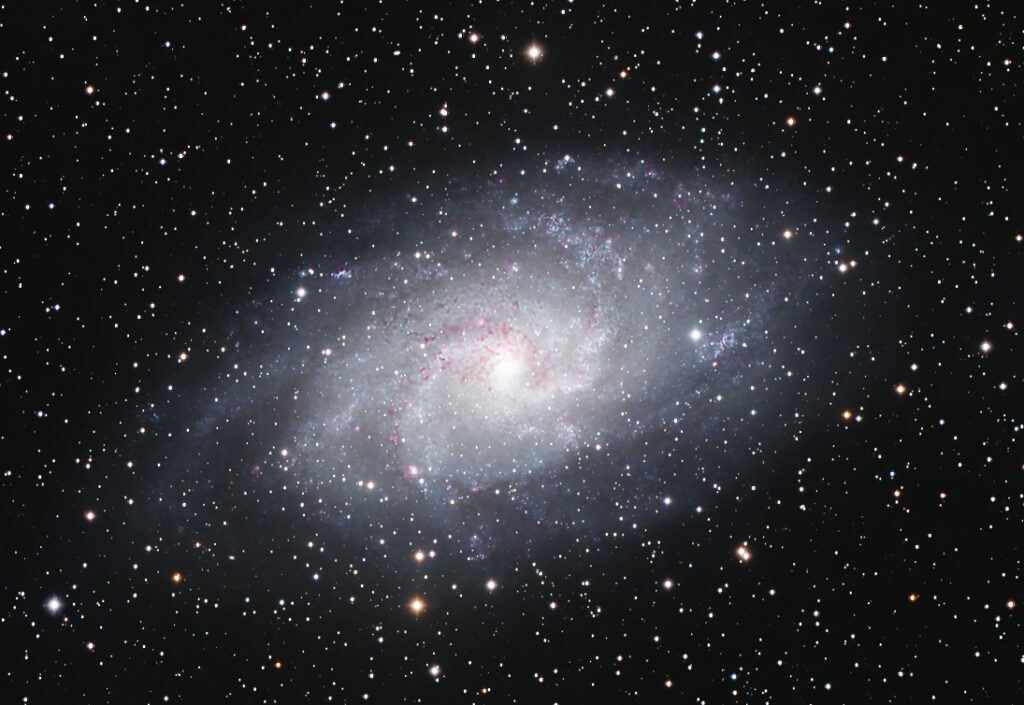
M33 from IC Spain Observatory, LRGB 600sec subframes recorded between 28/09/2021 and 16/01/2022 by Takahashi FSQ-106ED with Proline FLI PL16083 from Telescopelive network; astrobin https://www.astrobin.com/zkhypx/C/
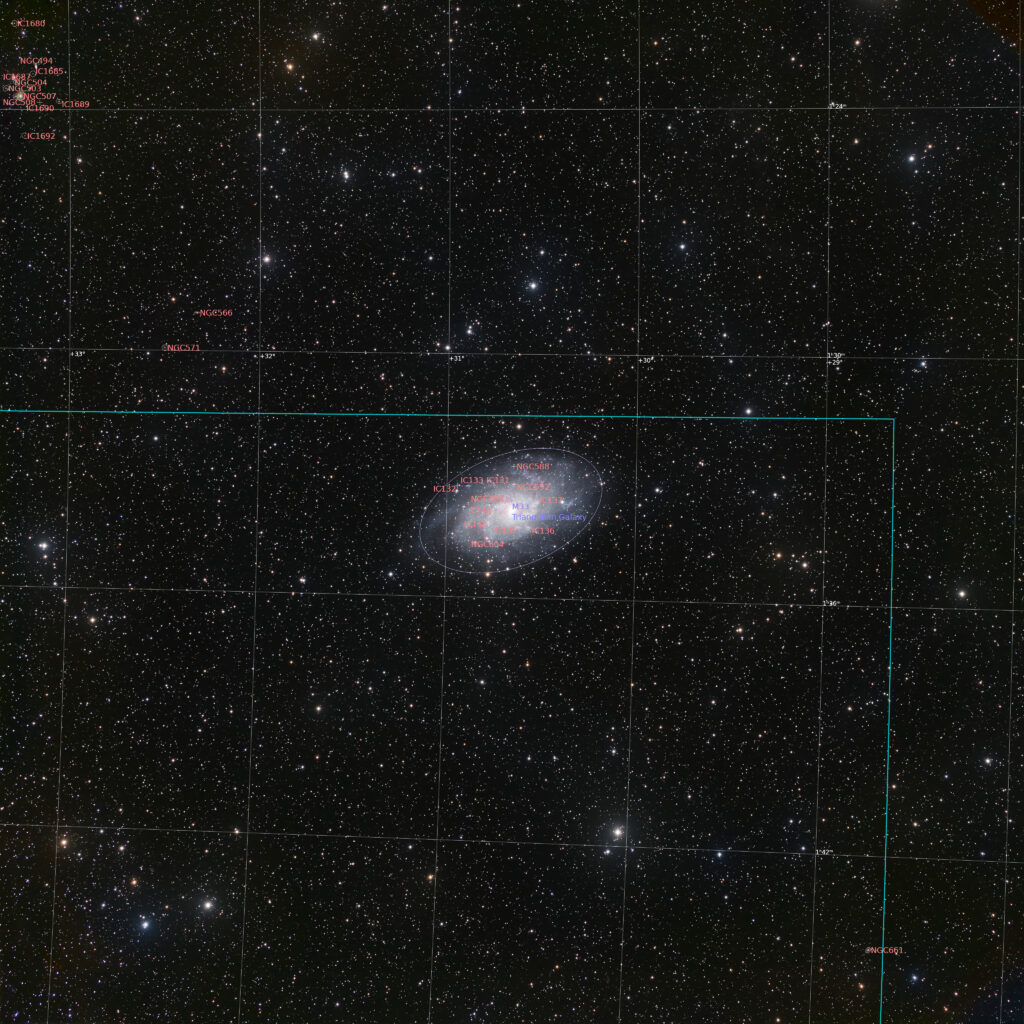
Original widefield cropped twice
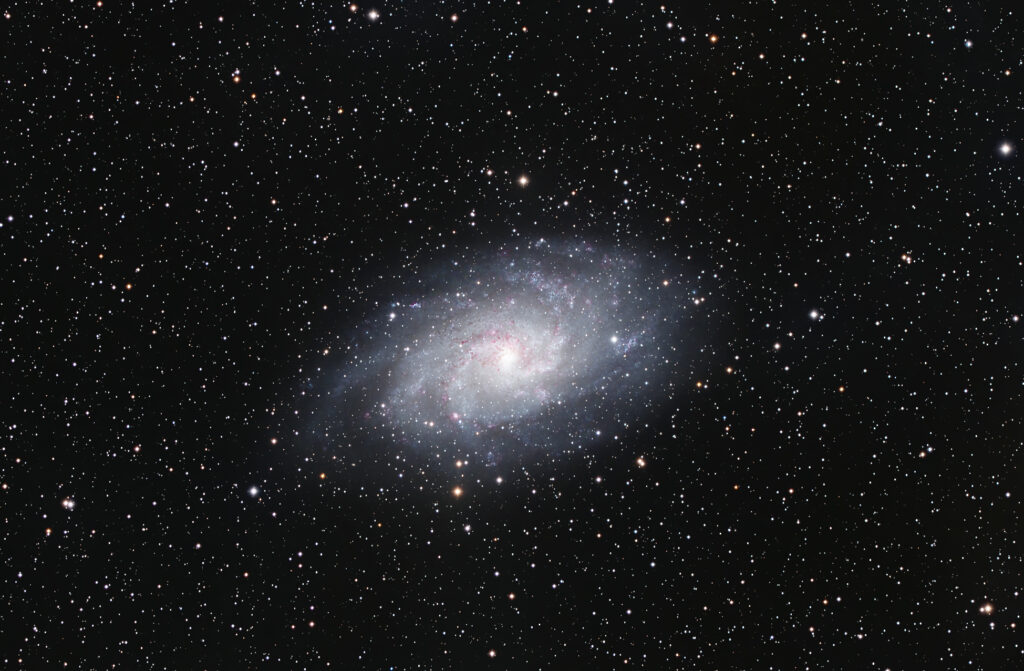
to better focusing about Galaxy.
M33 Galaxy lies among my best favourites targets and IMHO it is very difficult to be photographed.
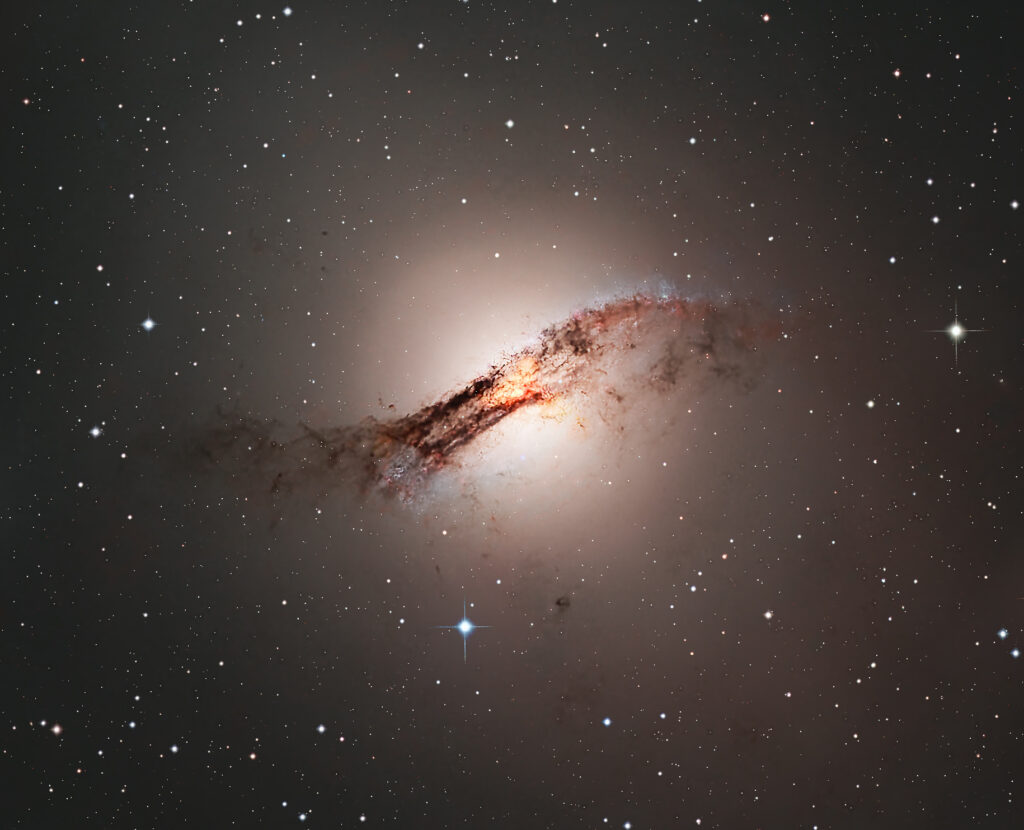
LRGB integration for Centaurus Alpha galaxy, Planewave CDK24 and Proline FLI PL9000, in the Rio Hurtado Valley of Chile, Telescopelive network.
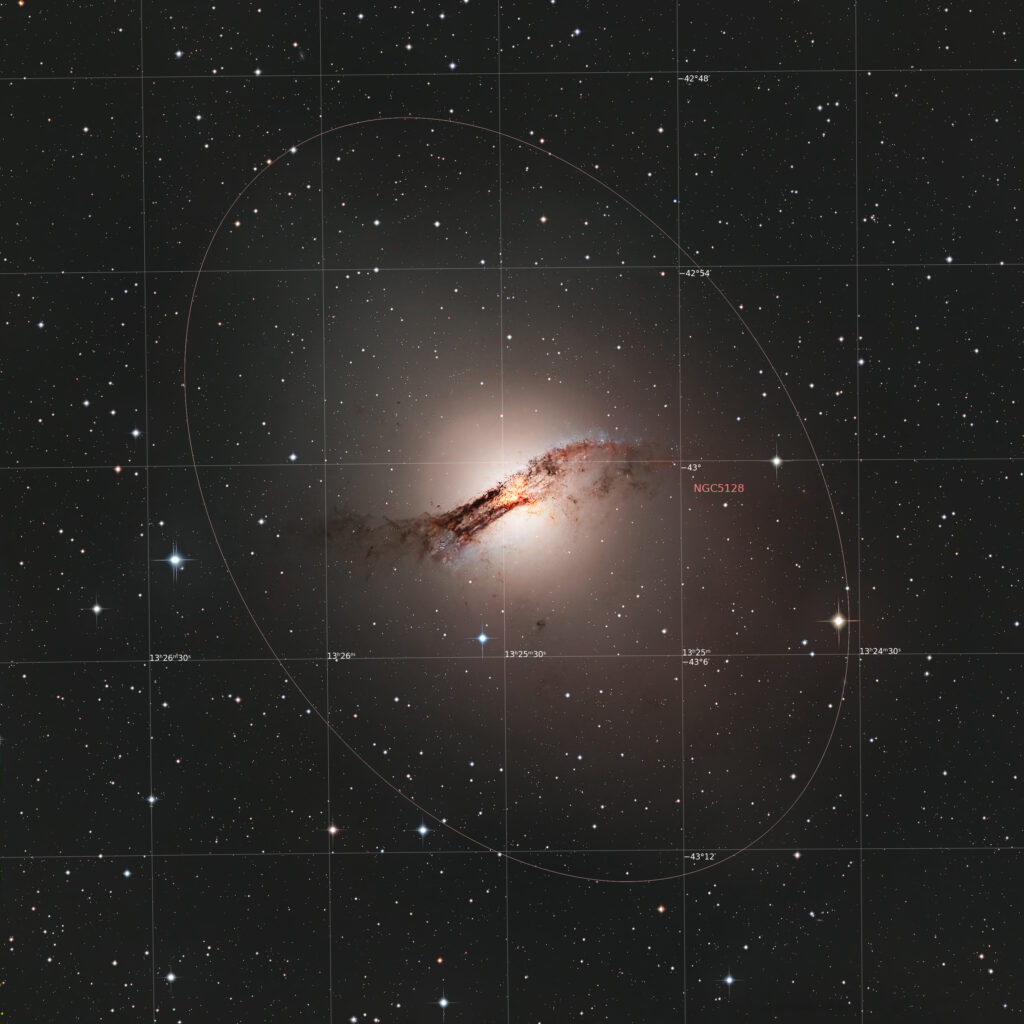
Annotated wider field integration.
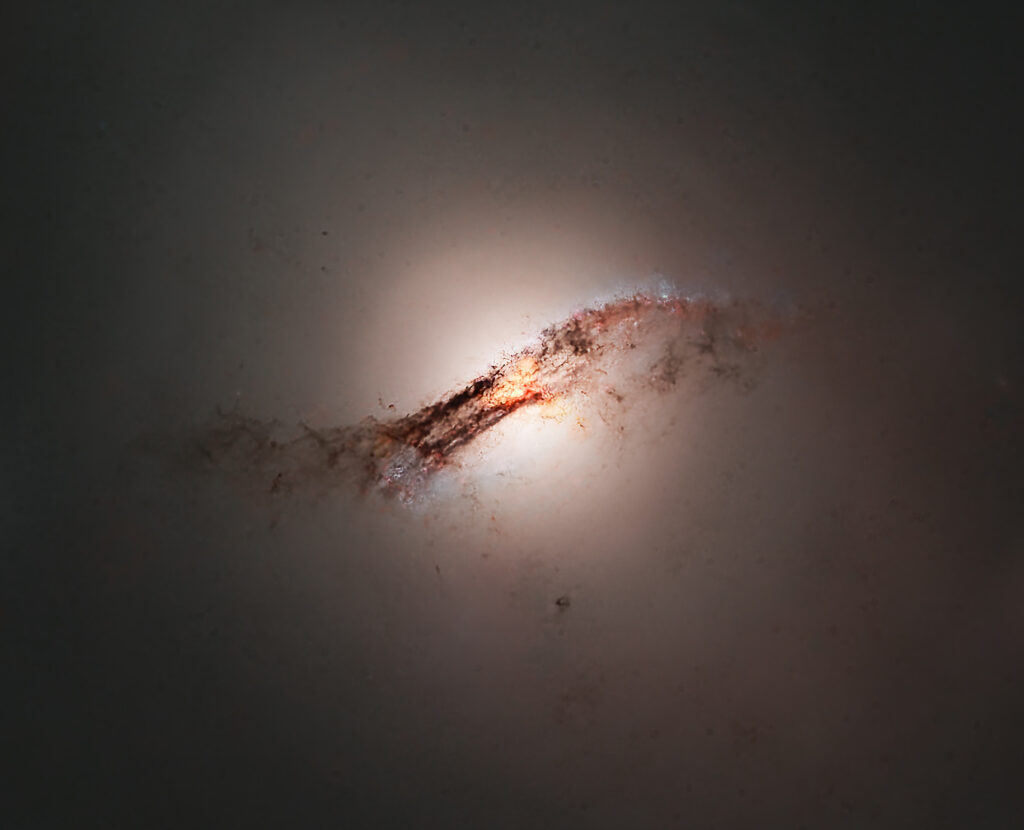
Starless stage of cropping focused on galaxy
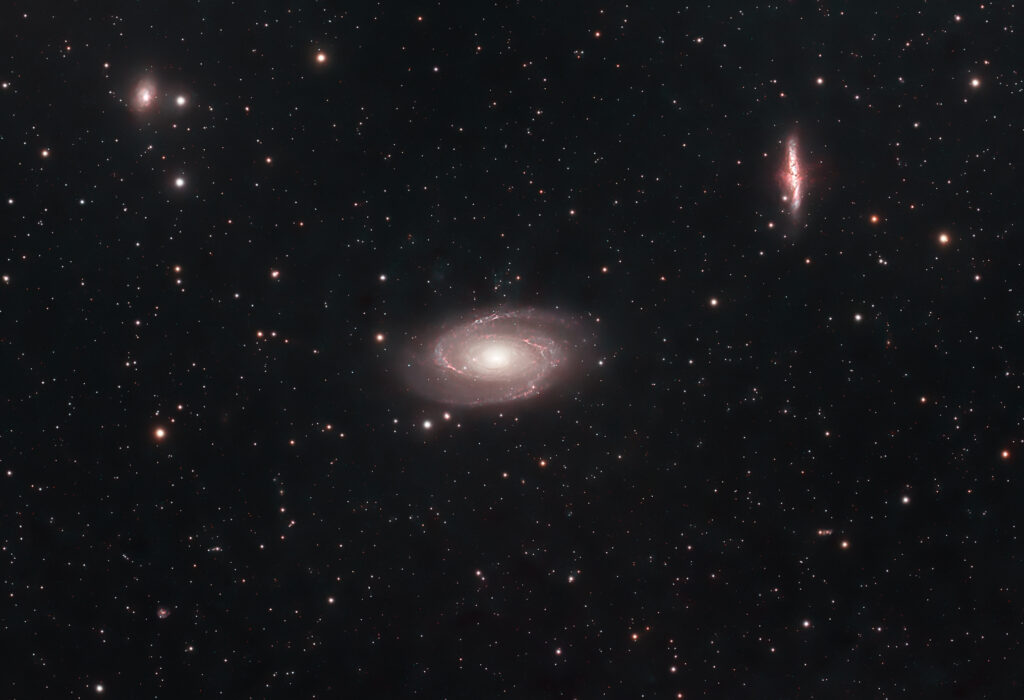
Astrobin:
During 2021 and 2022 I took a good number of subframes focusing on M81 and M82 field and I planned to integrate RGB channels with Ha and Oiii narrowband contribute.
Being a follower of John Rista short time DSO photography approach, RGB channel subframes I recorded at 60″, Halpha and Oiii subframes at 180″, William Optics Redcat51 and ASI1600mm Pro at -20 Celsius, Gain 139.
For Rista excellent studies, please cfr. https://jonrista.com/the-astrophotographers-guide/the-zwo-asi1600-guide/the-zwo-asi1600/preliminary-analysis/ and https://www.cloudynights.com/topic/578198-short-exposure-time-asi-1600mm-cool/ both on 02/08/2023.
After standard calibration, cosmetic correction by dark-master, star registration and winsorized sigma clipping integration, I obtained masterframe for each channel recorded.
Channel combination of RGB generated a good integration which I played with Ha and Oiii masters to Dynamic BG removal, solving (and annotated transparent layer version for further work), Spectrophotometric Color Calibration (just RGB) deconvolution and denoising.
I then proceed by starXterminator in starless and stars version of each master to work properly ‘till putting them back by PixelMath, obtaining a pretty good RGB master
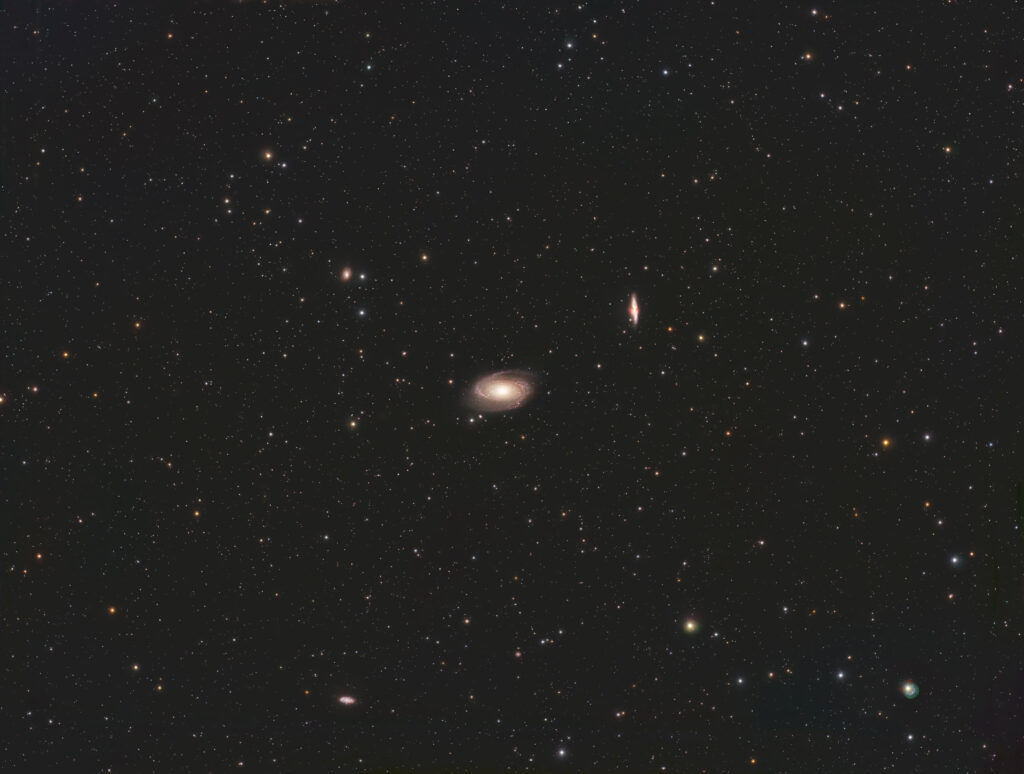
with ready-to-go Halpha and Oiii narrowband master to integrate within:
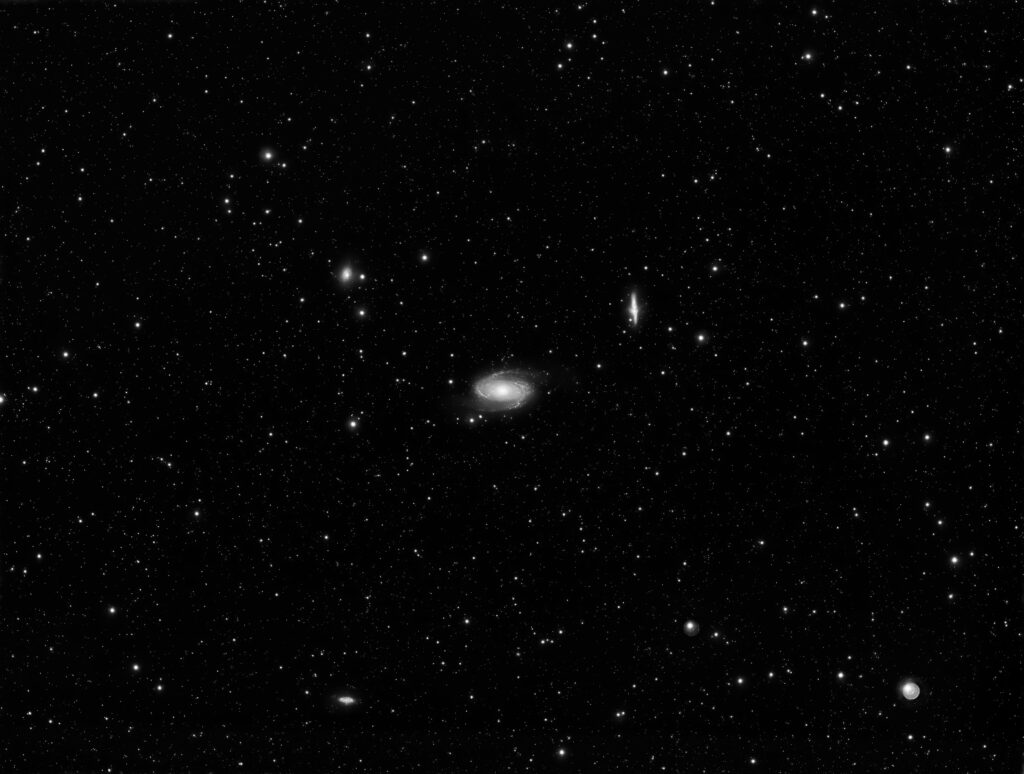
H alpha channel to be associated to R channel while Oiii to differently be integrated with both G and B channels.
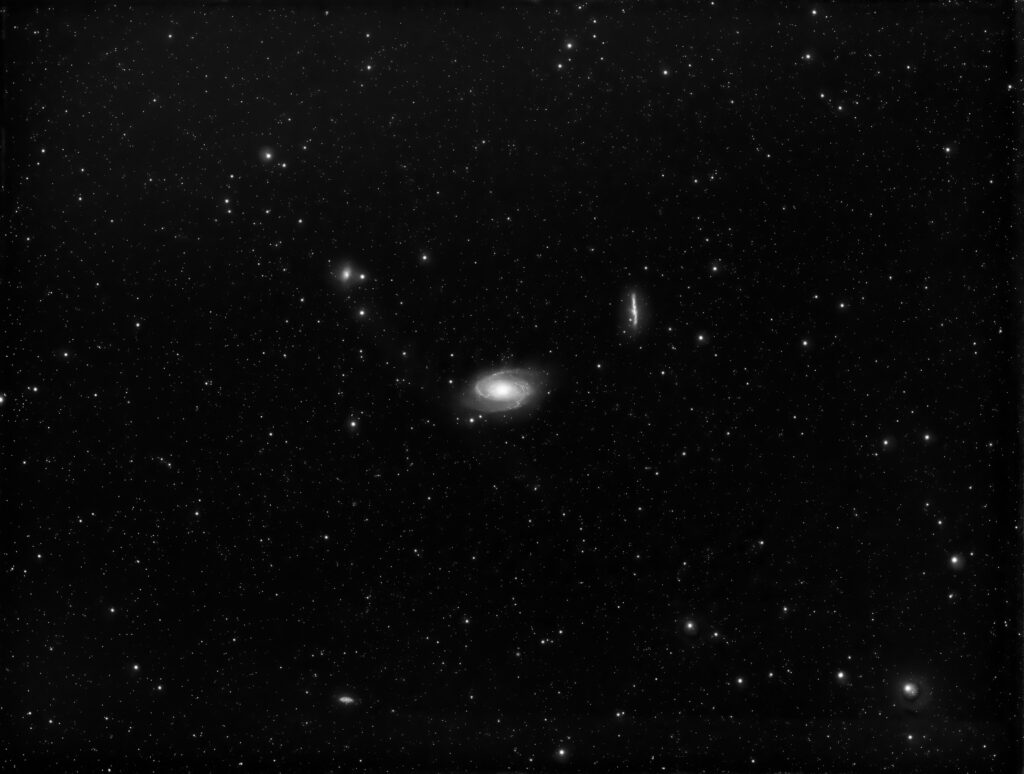
Narrowband with RGB integration produced a pretty good result which, in turns, I little worked over separating again stars and starless sub-master, finally directly melted in Photoshop.
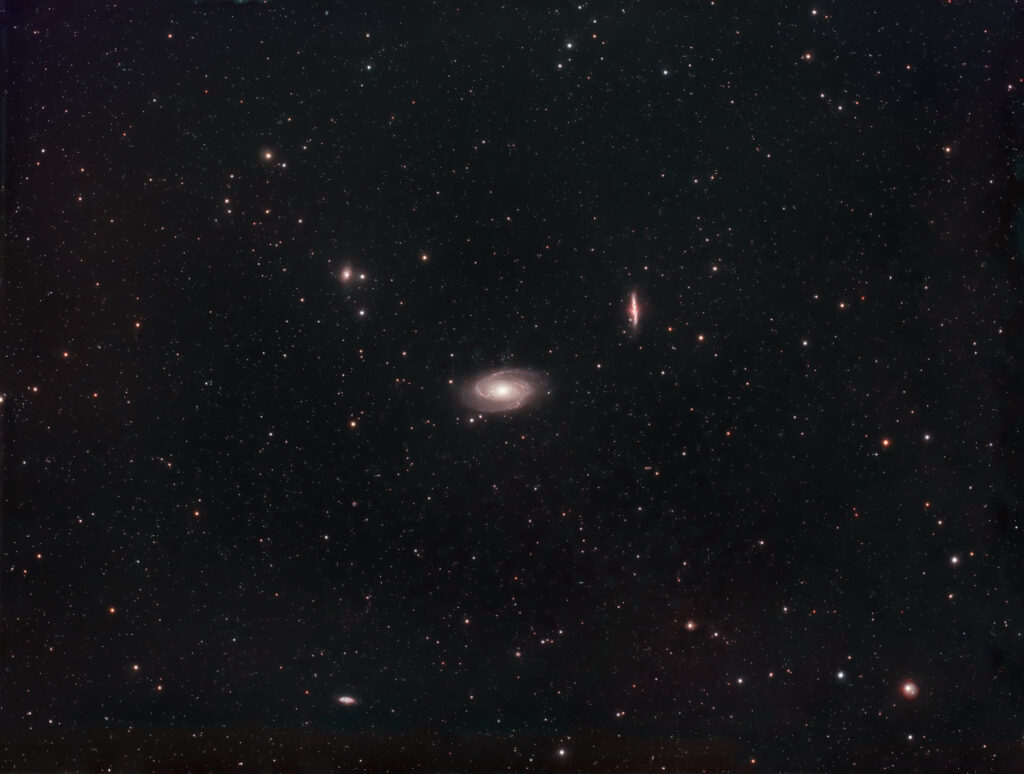
This portion of sky is so rich of galaxies; PGC annotation (PixInSight) gives an idea of the richness of field
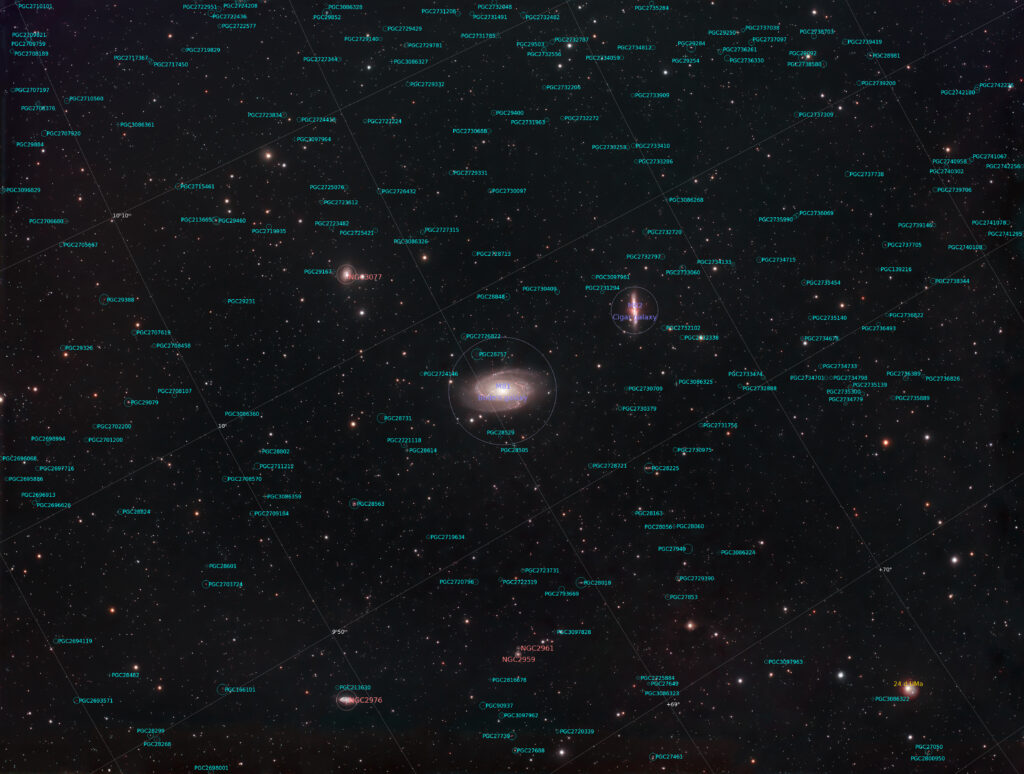
I thus start to try some crop solution for better framing and focusing the final image. At first I cropped a squared and a vertical version to catch in the field also NGC2976, NGC2961 and NGC2959.
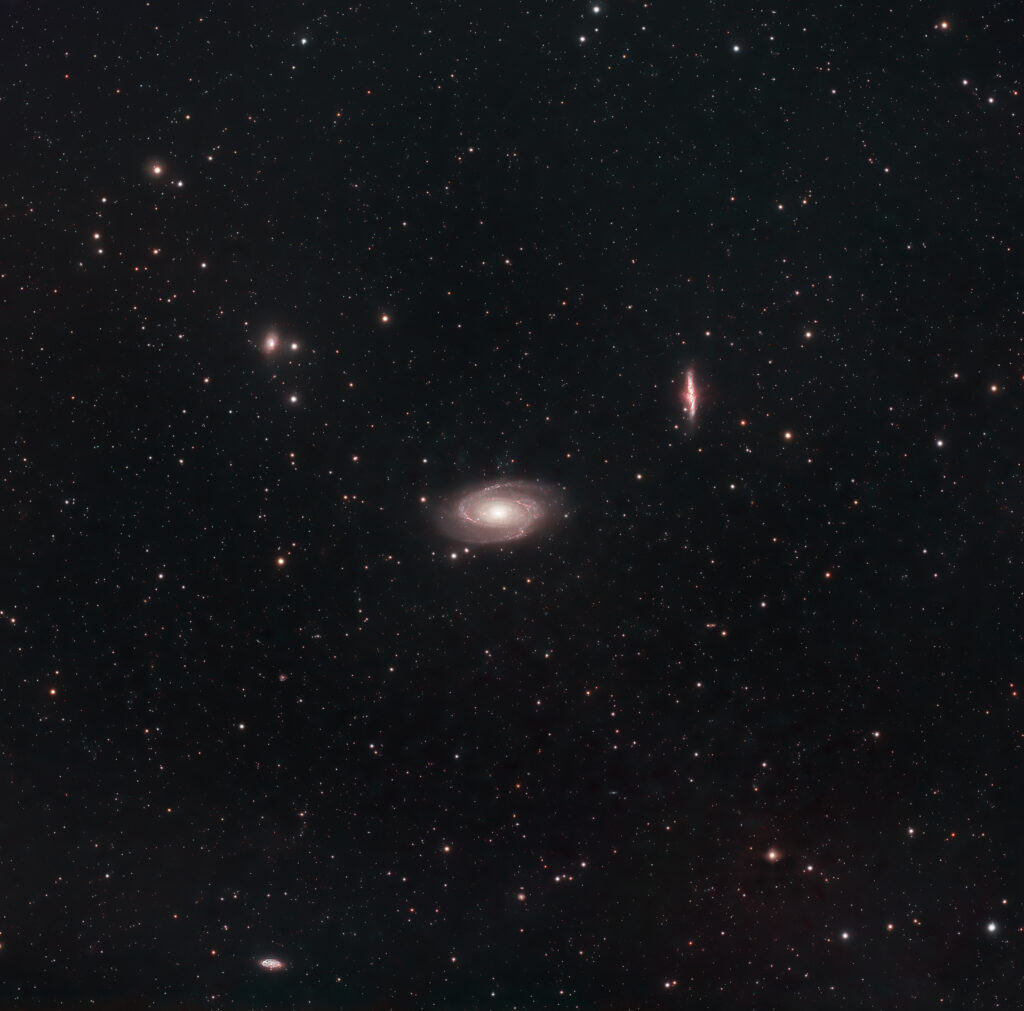
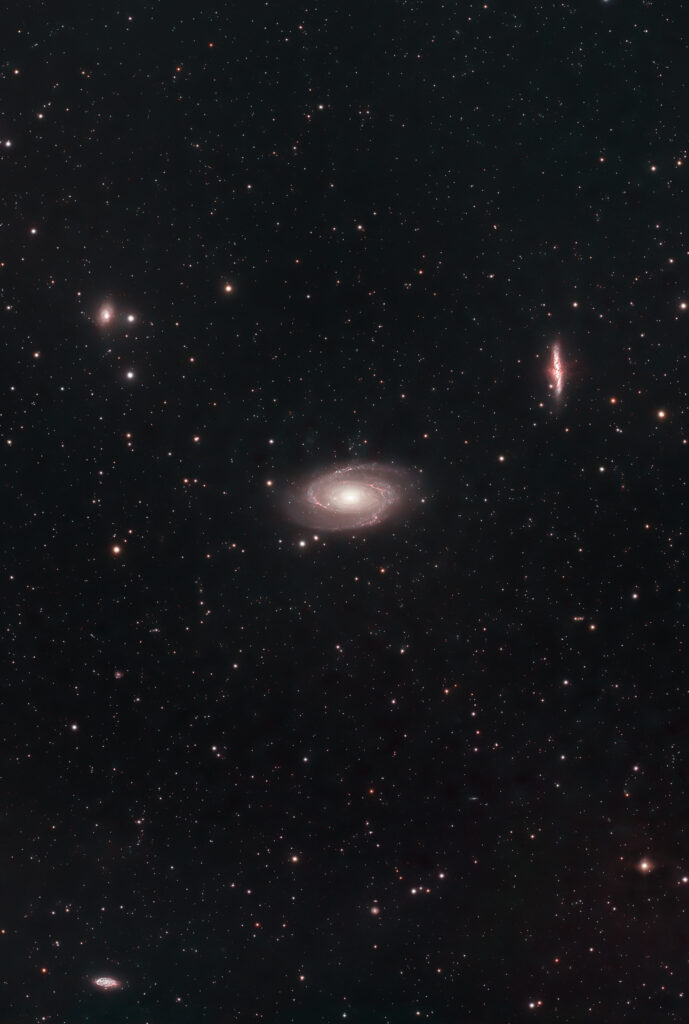
Finally I focused about M81 and M82 with a deep cropping for an orizontal composition, trying to dispose M81 and friends according to 3/4 grids basic composition rule.
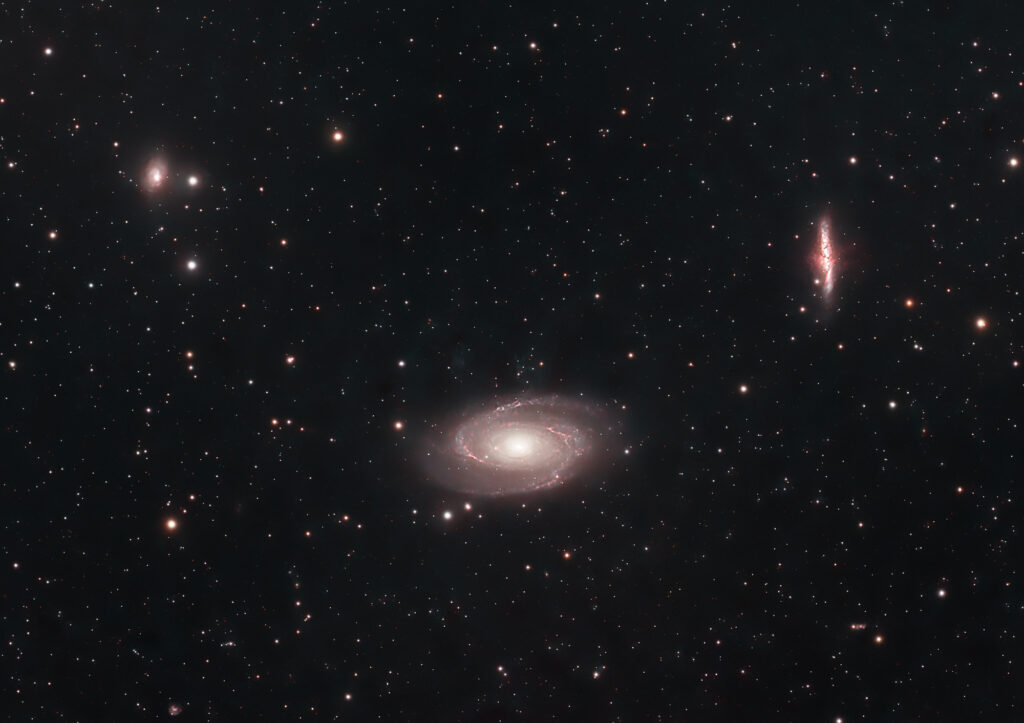
Photoshop, non cropped version, with 3 main crops framing as guide layer are available here
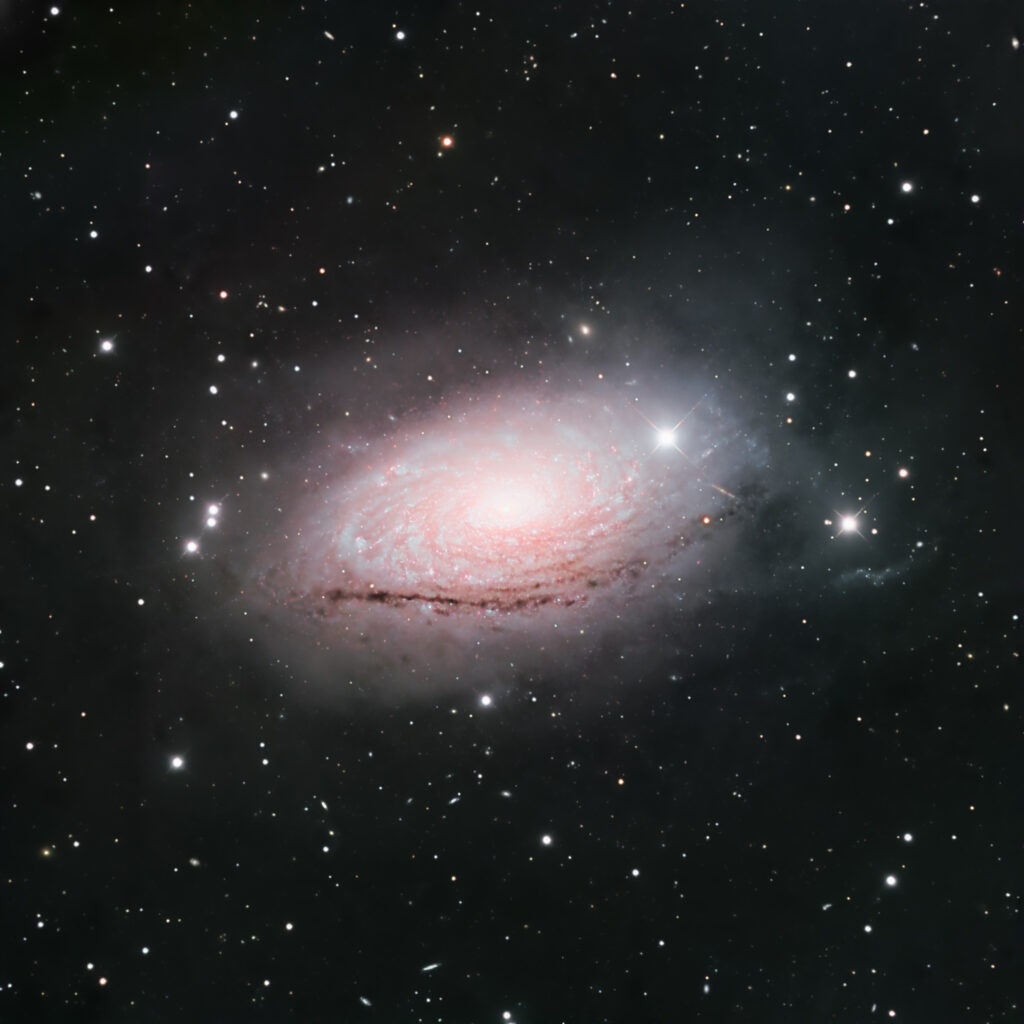
Spiral galaxy in the northern constellation of Canes Venatici belonging to M51 Group located to the southeast of the M101 Group and the NGC 5866 Group. The distances to these three groups are similar, thus the M51 Group, the M101 Group, and the NGC 5866 Group are actually considered as part of a large, loose, elongated structure; cfr.: https://arxiv.org/abs/astro-ph/9910501.
In the mid-19th century, Anglo-Irish astronomer Lord Rosse identified spiral structures within the galaxy, making this one of the first galaxies in which such structure was identified.
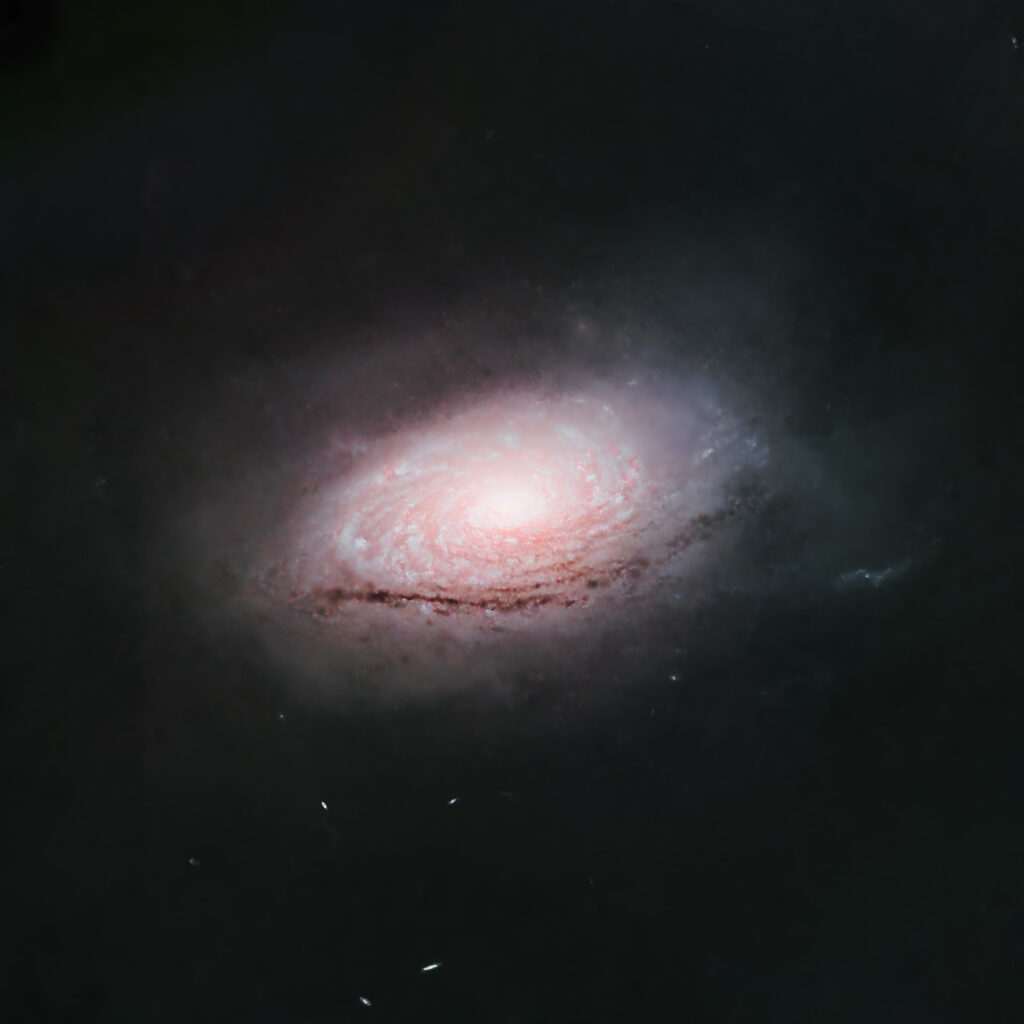
According to Ann, Ha et Al., 2015 [cfr.: https://arxiv.org/abs/1502.03545] catalogation of visual classified galaxies in local Universe the shape or morphology of this galaxy has a classification of SAbc where SA indicating a spiral form with no central bar feature, and bc describes a moderate to loosely wound arms, as evinced from a visible light observation with general lack of large-scale continuous spiral structure, thus M63 is considered a flocculent galaxy.
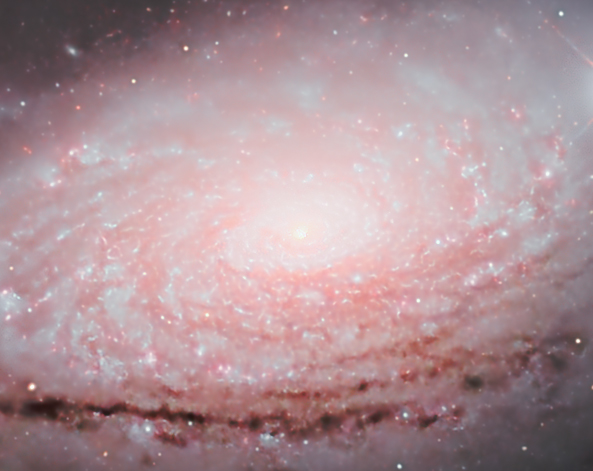
According to Thornley, 1996, when observed in the near infrared, a symmetric, two-arm structure is seen and each arm wraps 150° around the galaxy and extends out to 13,000 light-years (4,000 parsecs) from the nucleus; cfr. https://arxiv.org/abs/astro-ph/9607041.
According to Graham, 2008, the existence of a supermassive black hole (SMBH) at the nucleus is uncertain. If it’s true then its mass could be estimated as (8.5±1.9)×108 M☉, in few words around 850 million times the mass of our star the Sun; cfr.: https://arxiv.org/abs/0807.2549
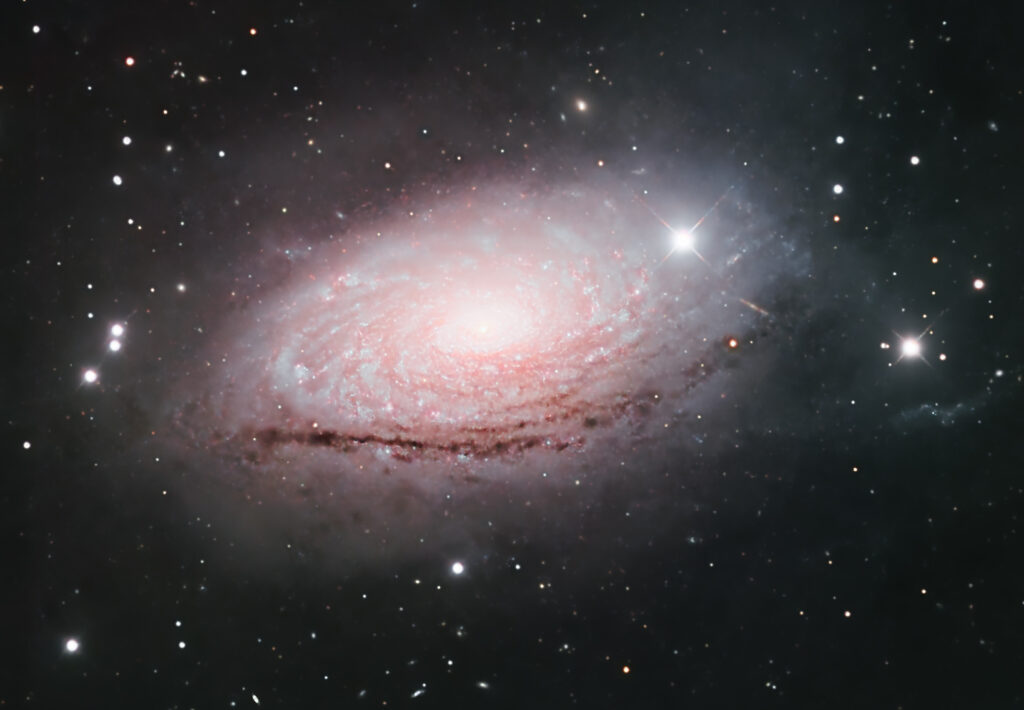
Tully, Courtois and Sorce researches focused on galaxy distances measured M63 at 29.300.000 light years, alias 8.99 megaparsec. Cfr.: https://arxiv.org/abs/1605.01765
In this work I use bundle observation from Telescopelive Spain 2 CCD Officina Stellare 700mm RC.
First, by PixInSight, Cosmetic Correction was required to better recalibrate subframes, especially removing vertical couple of lines. Then the same registration, integration, bg removing, spcc, deconvolution and denoising routine to generate LRGB masterframe, while in parallel, working on Luminance master for final Photoshop image reconstruction, with starless and stars levels blending – respectively in luminosity (L) and screen (Stars) mode.
Astrobin:
Framelist available here:
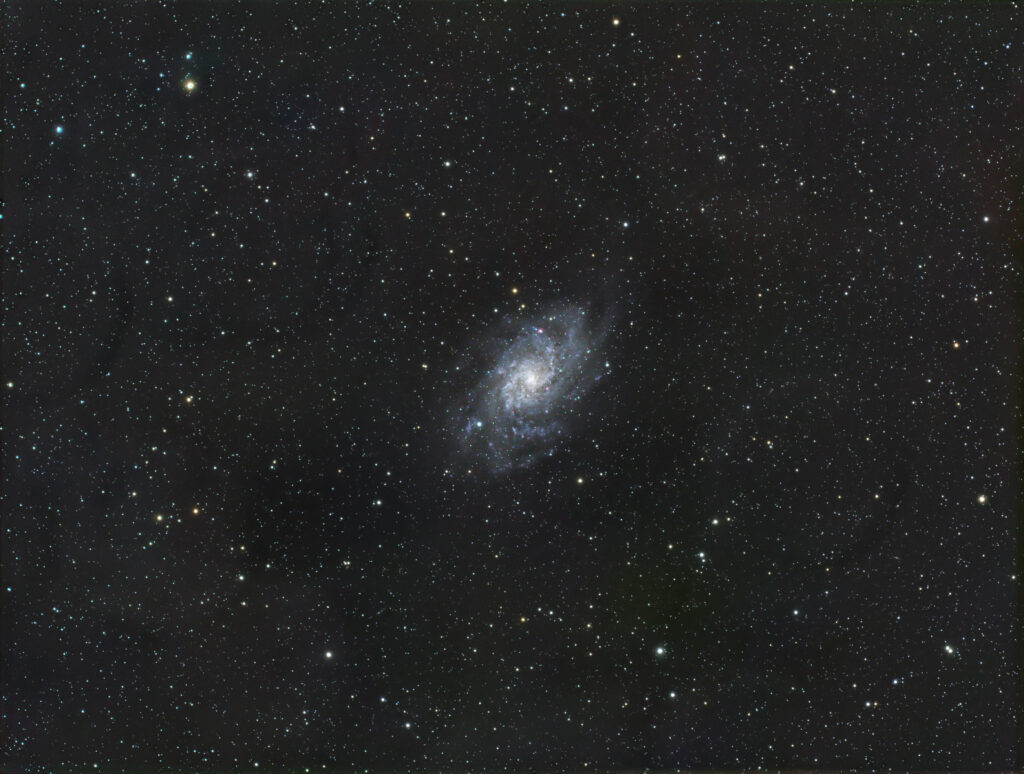
Astrobin:
Astrometry:
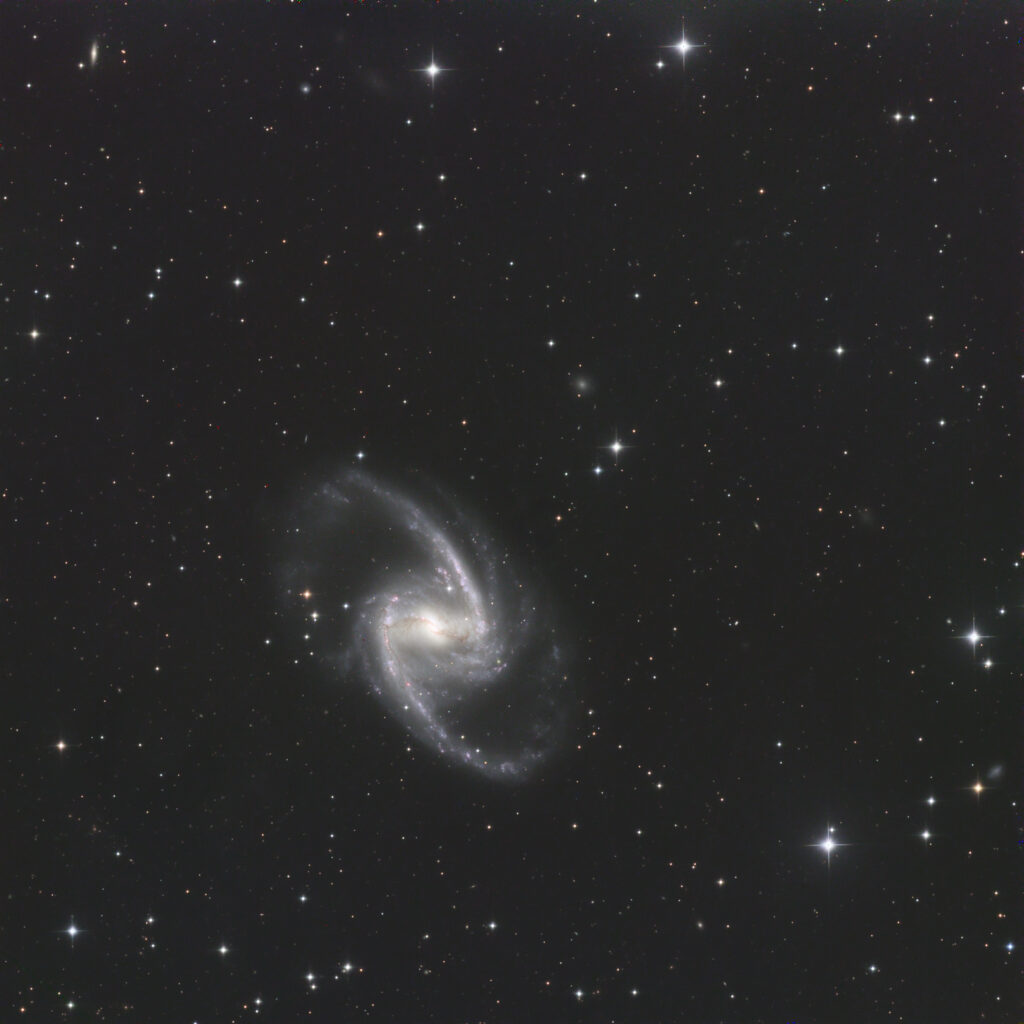
Astrobin: https://www.astrobin.com/n61k17/
Astrometry: https://nova.astrometry.net/user_images/7470441#annotated
Telescopelive: https://telescope.live/gallery/ngc1365-5
Link: https://www.xiulong.it/tianwensheying/2023/03/06/ngc-1365-great-barred-spiral-galaxy/
Link al TIFF/FITS: https://www.dropbox.com/s/lomf3scyuzq967j/LRGB_lfG_DBEspccDECONVezdenoise.xisf?dl=0
Scarica il file originale: Scarica
Telescopi O Obiettivi Di Acquisizione: Planewave CDK24
Camere Di Acquisizione: FLI PL9000
Montature: Mathis Instruments MI-1000/1250
Filtri: Astrodon Gen2 E-Series Tru-Balance Blue 50×50 mm · Astrodon Gen2 E-Series Tru-Balance Green 50×50 mm · Astrodon Gen2 E-Series Tru-Balance Lum 50×50 mm · Astrodon Gen2 E-Series Tru-Balance Red 50×50 mm
Software: Adobe Photoshop · Pleiades Astrophoto PixInsight
Date:29 Gennaio 2021 · 28 Gennaio 2022 · 29 Gennaio 2022 · 01 Febbraio 2022Pose:
Astrodon Gen2 E-Series Tru-Balance Blue 50×50 mm: 8×600″(1h 20′) -25°C bin 1×1
Astrodon Gen2 E-Series Tru-Balance Green 50×50 mm: 8×600″(1h 20′) -25°C bin 1×1
Astrodon Gen2 E-Series Tru-Balance Lum 50×50 mm: 8×600″(1h 20′) -25°C bin 1×1
Astrodon Gen2 E-Series Tru-Balance Red 50×50 mm: 8×600″(1h 20′) -25°C bin 1×1
Integrazione: 5h 20′
Giorno lunare medio: 16.88 giorni
Fase lunare media: 32.18%
Scala del Cielo Scuro Bortle: 1.00
Centro AR: 03h33m23s.864
Centro DEC: -36°04′55″.95
Campionamento: 0,620 arcsec/pixel
Orientazione: -1,195 gradi
Raggio del campo: 0,372 gradi
Trasformazione WCS: thin plate spline
Info:Apri
Trova immagini nella stessa area
Risoluzione: 3056×3056
Dimenzione file: 53,5 MB
Luoghi: El Sauce Observatory, Chile, Coquimbo, Cile
Origine dei dati: Osservatorio remoto di proprietà
Origine dei dati remoti: Telescope Live
After James Webb Space Telescope MIRI and NIRCAM data, I focused about NGC 1365 Great Barred Spiral Galaxy, and found good calibrated data from Telescopelive archive to be downloaded and elaborated.
Telescope: Planewave CDK24 610/3962mm (CH-1-CCD)
Camera: Proline FLI PL 9000
Location: El Sauce Observatory, Chile
600″ x LRGB subframes, taken between 28/01/2022 and 01/02/2022
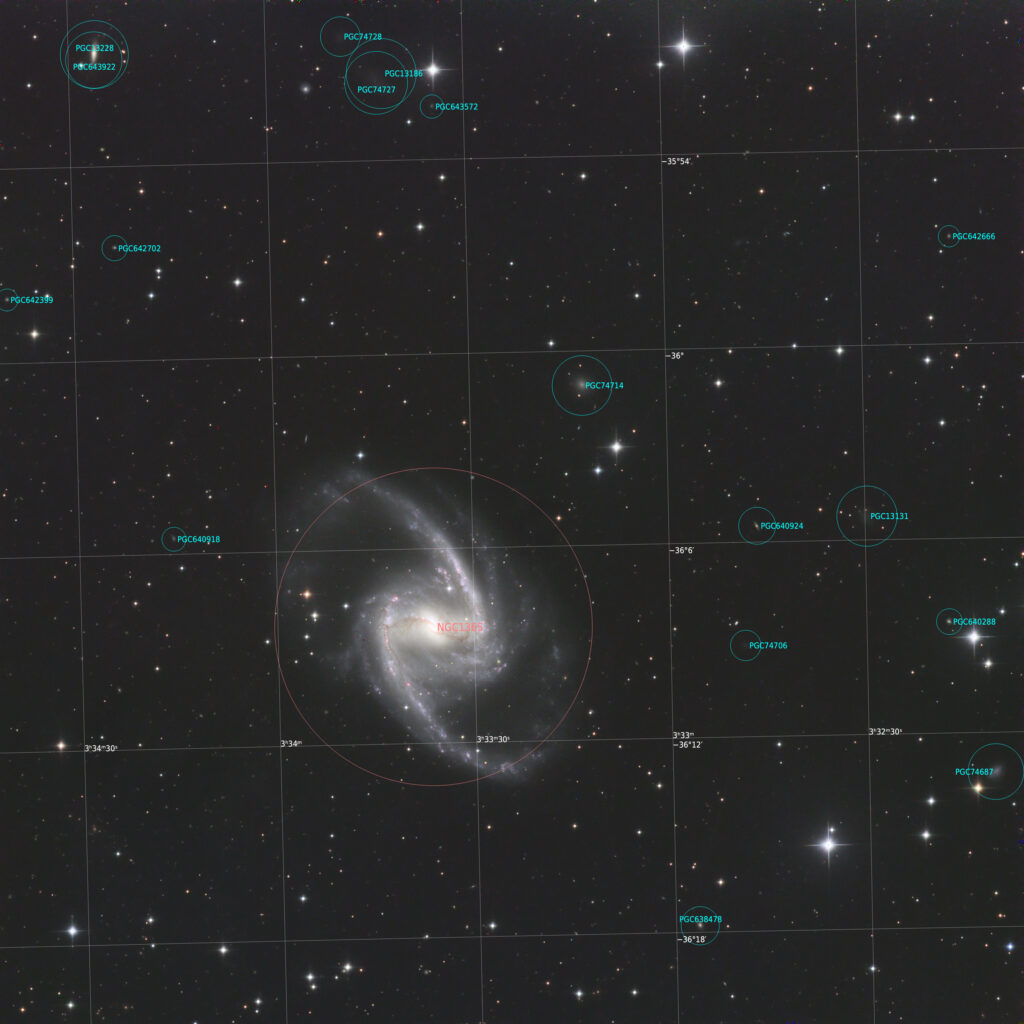
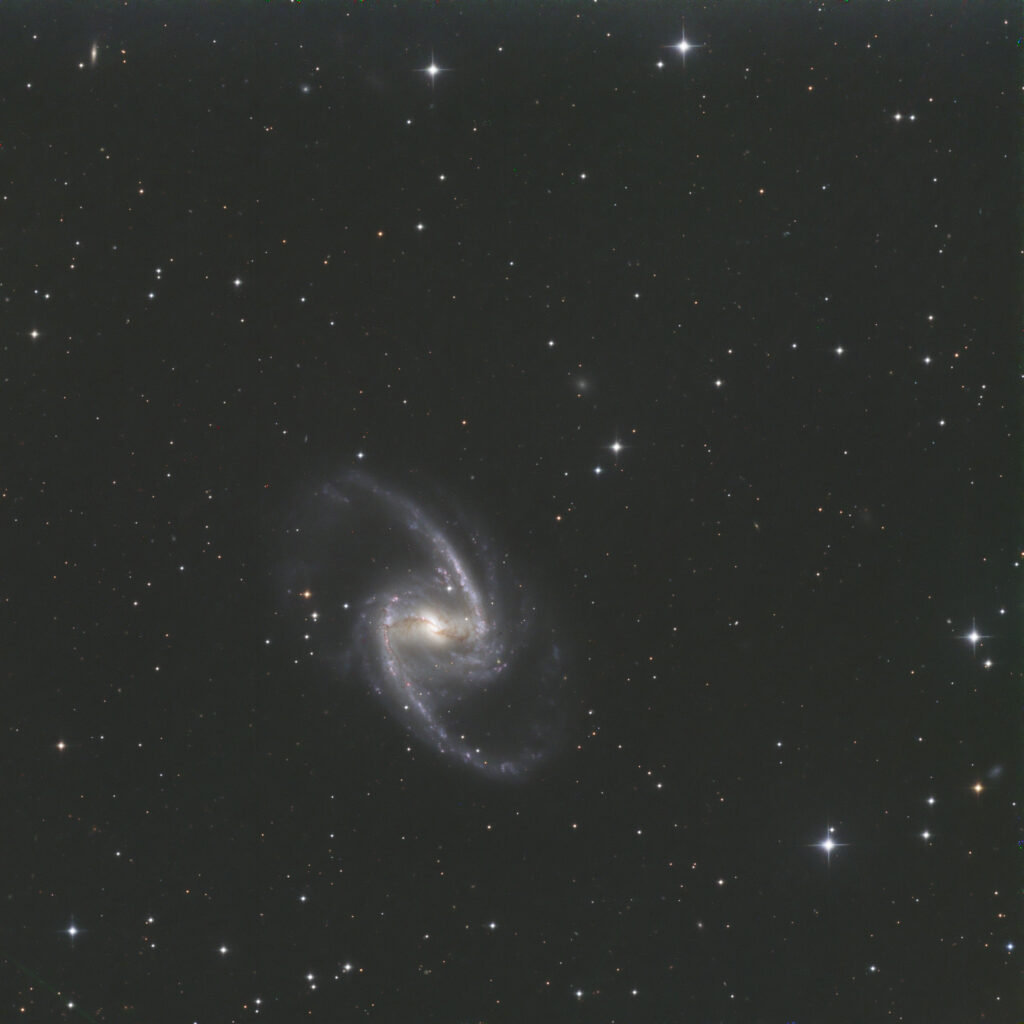
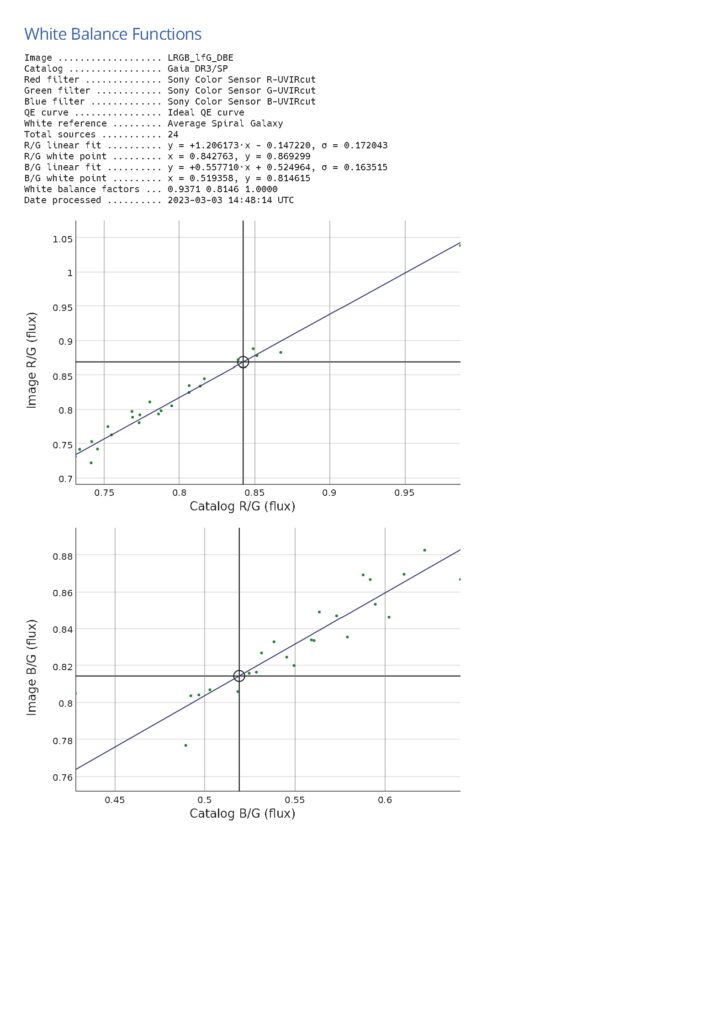
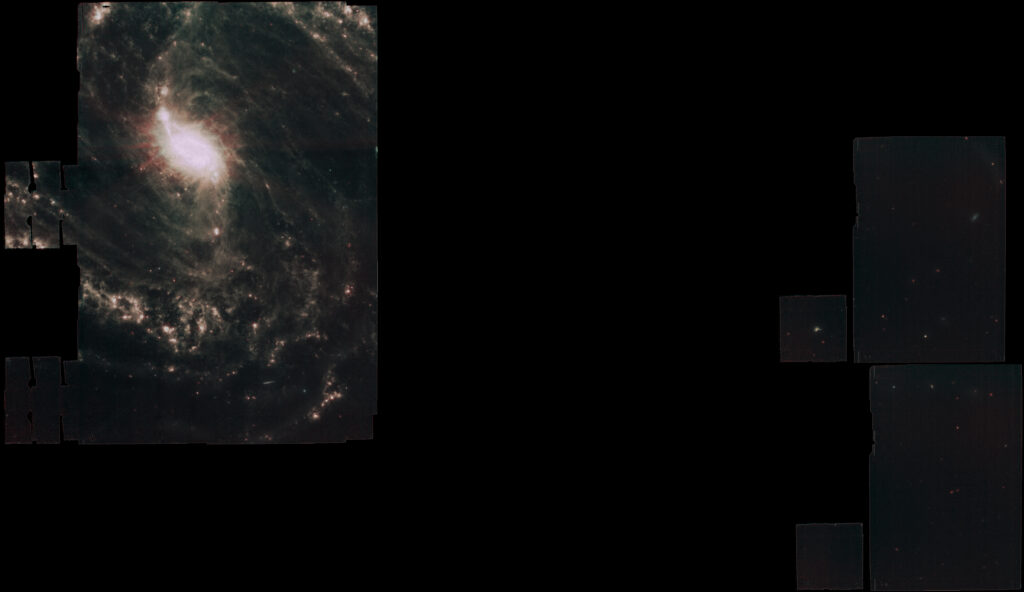
According to James Webb Space Telescope official documentation (cfr. https://jwst-docs.stsci.edu/jwst-mid-infrared-instrument) the JWST Mid-Infrared Instrument (MIRI) provides imaging and spectroscopic observing modes from 4.9 to 27.9 μm. These wavelengths can be utilized for studies including, but not limited to: direct imaging of young warm exoplanets and spectroscopy of their atmospheres; identification and characterization of the first galaxies at redshifts z > 7; and analysis of warm dust and molecular gas in young stars and proto-planetary disks.
MIRI imaging filter curves and wavelenght are resumed below


From Mikulksky Archive for Space Telescopes I downloaded raw calibrated .tif data focused about NGC 1365 Great Barred Spiral Galaxy, a double-barred spiral galaxy about 56 million light-years away in the constellation Fornax.
Among all data available I picked-up 3 sessions: a wide field MIRI mosaic by filters f770W, f1000W, f1130W and f2100W, a small field MIRI mosaic by the same filters f770W, f1000W, f1130W and f2100W a small NIRCAM field mosaic by filters f200W, f300M, f335M and f360M.
